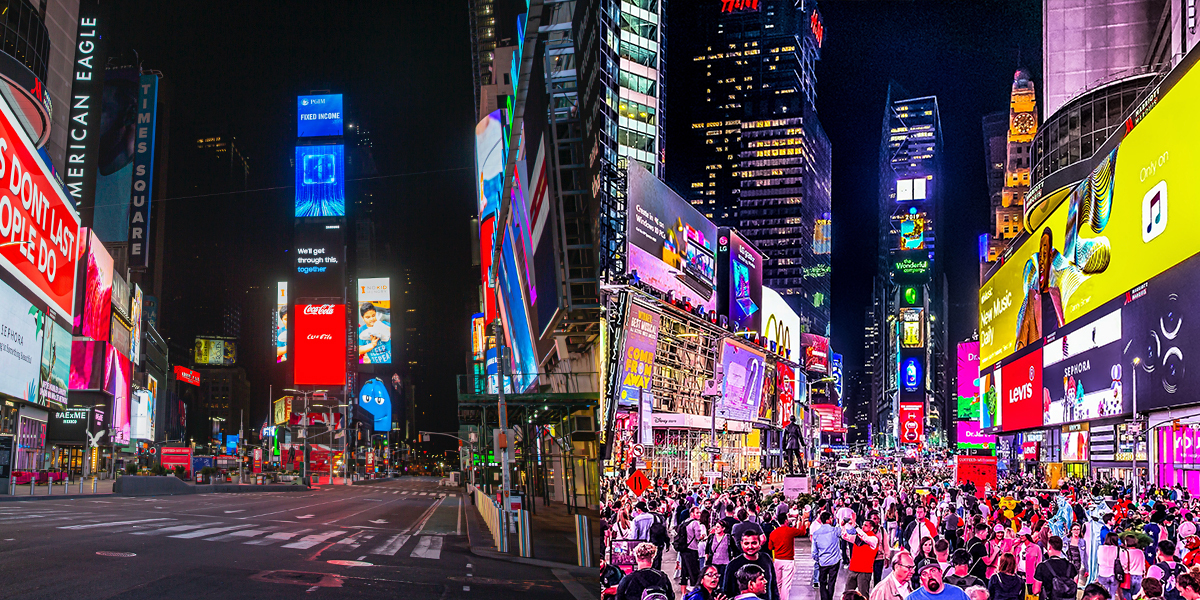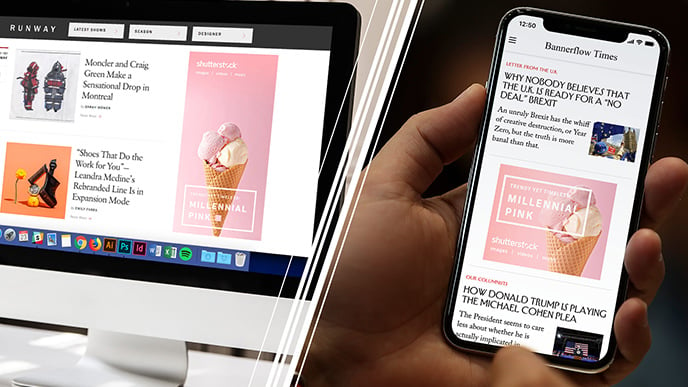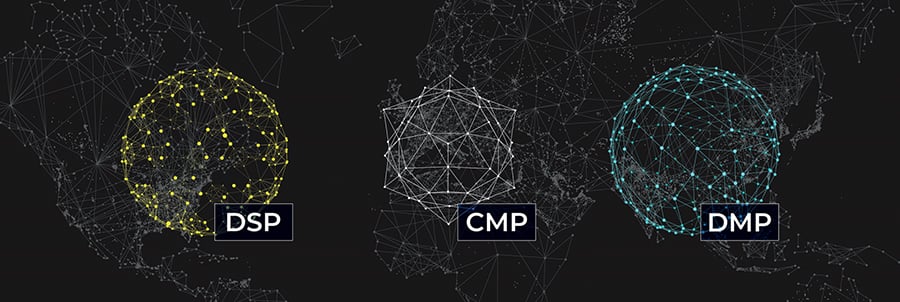Premium financial services ads – particularly display campaigns– are essential in 2021. Not only that but they are set to play a prominent role in the future fortunes of many brands. Whether fintech, traditional banks, trading or insurance, the global pandemic is forcing both adaptation and transformation across marketing teams as margins grow ever tighter.
And in the face of increasing online competition, many financial brands are looking to new digital technologies. As well as working hard to improve their ability to react in a timely way. After all, even the smallest adaptation to your display advertising practice can result in huge improvements!
Indeed, there really is no time like the present when it comes to putting new strategies into action, with consumers now firmly digital-first thanks to the impact of the global pandemic. In this article, we suggest following strategies to help your brand create its best ever financial service ads:
- Increasing production via automation
- Standardising branding across all ads
- Reacting in real-time, every time
- Engaging with cost-free interactivity
- Combining display and social production
- Automating creative optimisation
- Personalising financial services ads
1. Increasing production via automation
Firstly, it goes without saying that to perform display advertising at volume, you need the ability to create pixel perfect ads fast. And when it comes to display advertising, making sure your team has the tools they need is a dealbreaker when it comes to delivering.
What does this mean for financial services ads?
It means the next time you see chatter about wild trading opportunities, you won’t have to wait weeks to join the conversation. Instead, you simply create a new master creative! Then scale your concept to all the sizes and formats you need. Then select your audience and publish a new campaign to all your preferred networks. In minutes your brand is part of the reaction – not the aftermath.
And where does automation come in?
An ad creator, such as Bannerflow’s Creative Studio, enables marketing teams to automate the production of display and social campaigns. A single designer can now create ads in any format and size in minutes. How you ask? Thanks to features such as smart scaling and creative automation. These technologies remove or cut time consuming and expensive small repetitive design tasks.The result: teams are able to export lots of ads, for multiple channels, in a short space of time.
2. Standardising branding across all ads
Hitting the target in local markets when it comes to advancing your ads from static to HTML5 responsive display ads can feel like a huge jump.
Additionally, across the world, regulatory guidelines for banking, payments, insurance and fintech vary and change on a regular basis. Not only that but any regulation must be abided by within the constraints of a banner ad – a tough job.
But adopting HTML5 responsive ads are a risk worth taking when you realise the benefits it brings in terms of brand consistency and adaptability.
Using an ad creator such as Creative Studio, a single HTML5 master creative is easily transformed into brand consistent variants for secondary, tertiary or more markets. Saving your marketing team time and money.
What’s more, being able to offer consistent, premium, standardised campaigns, which are easily and quickly adapted for cultural, religious or practical needs, puts your brand in an enviable position – on a global scale.
You can easily take the strain out of potential human error by programming an ad set for specific markets. This means whenever a variant is made for a specific market it will always include the terms and conditions for your campaigns. Additionally, you could set a fade out after an agreed period of time.
3. Reacting in real-time, every time
In financial services producing trend-based campaigns, designed to engage audiences on the fly is challenging.
Sound familiar?
Yet, there is a simple answer. Real-time solutions, such as those available in campaign management software enable marketing teams to update live financial services ads instantly with the latest offers or products. Here are two strategies your brand could adopt:
Direct publishing
Seamless integrations between a campaign management solution and ad networks not only streamline publishing processes but enable full real-time control too. Thus live ads and entire campaigns can be updated in an instant across markets.
Data feeds
Data feeds are a great way of making your display campaigns both dynamic and relevant. They offer the ability to present consumers with ‘live’ content.
An automatic data feed uses a spreadsheet to regularly update the content in an ad. These can contain data such as words, and sentences, numeric values, image URLs, and links. While, a live data feed offers the ability to pull live data from your product and pricing inventory, and display that too.
For example, you could schedule multiple offers to appear and disappear during the day. Or you could supply live updates of the exact exchange rates, or even mortgage packages sold during a specific timeframe.
Using real-time updates positions your brand as relevant. It also means you stay on top of news and create curiosity for consumers not wanting to miss future information from you.
4. Engaging with cost-free interactivity
The days of boring static and unengaging ads are over.
Catching the eyes of a consumer for just a few seconds longer in a saturated, native ad packed screen is a must. Therefore, adding impact, or something a bit different, perhaps even gamified, puts your brand in the driving seat.
But how can you achieve this without spending hours coding your campaigns. And avoid costing your brand a small fortune?
Say hello to drag and drop Rich Media
Interactive display advertising can come in many forms, from either a live form, or video in a banner, to a full-on mortgage calculator. However, interactive campaigns are best produced using HTML5 Rich Media widgets. These enable rich interactivity to be added without fuss and remove the need for expensive manual coding.
Indeed, the ability to drag and drop interactive elements and customise them to your own brand should be there as standard in any premium ad creator in 2021. Why? As they make interactivity ads cheaper and faster. If it’s not, we suggest upgrading your software!
Video, audio, and animation are all powerful techniques for capturing your audience’s attention. And by using the power of rich media you can bring your brand to life. Moreover, creativity enables your financial ads to display what your brand is all about, emotionally and, if you’re brave, via tactile interactivity.
5. Combining display and social production
More than half of the global population now use social media. We suggest now is the time to combine display and social ad design production to increase ROI.
Automate display and social production
Making full use of a premium ad creator means you can use its smart scaling feature to create and export social media ads via the same master creative as your display ad. Or, of course, vice versa!
Not only does this save your designers time but it means you can create entire cross-channel campaigns, for any of the major social networks at high speed. This is particularly useful when you are running a series of ads across display and other channels. Thus, you can seamlessly connect your strategy, stay consistent, and streamline workflows.
Indeed, being able to simply do all your advertising within one platform, will both save your business time and maximise marketing ROI. Essentially, it’s now possible to have an idea in the morning, and a powerful financial display campaign live by the afternoon.
6. Automating creative optimisation
Creative optimisation refers to the process of optimising display ad creative and copy based on data. Often time consuming and performed via A/B testing – there is another method which has the potential to bring even more value to financial services brands.
Introducing auto-optimisation
Auto-optimisation of creative optimisation is not a traditional A/B test, which needs cookies to operate. It doesn’t waste time and budget finding exact conversion rates for all variations – even the worst performing ones.
Instead, an auto-optimisation algorithm considers each financial services ads impression as a unique test. Minimising the number of impressions served to underperforming ads and maximising performance instead. Begin with as many ad variations as you want and quickly the auto-optimisation will find your best performing creative.
Used in combination with a powerful ad creator, ads can be optimised in minutes without needing to write a single line of code! Meaning that designing more ads for testing and being able to tailor ads to different audiences has never required less time.
7. Personalising financial services ads
Financial services display advertising is a marathon and not a sprint. And that’s certainly true if you want efficient campaigns and great results.
One-to-one personalisation through dynamic creative optimisation (DCO) offers the ability to hit viewers with the right ad, at the right time, with the best creative.
They are the ultimate combination of engagement and value. For example, a personalised campaign for the much delayed Tokyo Olympic Games was able to achieve a 63% higher engagement at a 50% lower CPA than standard formats.
One-to-one personalisation is the most advanced technique for connecting with your audience via display advertising. Not only can it show the right product or offer at the right time to a specific viewer but it enables you to use a variety of display strategies, real-time updates, and rich media interactivity depending on your preferred viewer.
Personalisation is a journey
However, before jumping straight to pure one-to-one personalisation, it’s worth honing your display competency. Make sure you experiment with at least one of the following at scale first:
- Dynamic display advertising which uses data feeds
- Creative optimisation via an auto-optimisation tool
- Audience personalisation – display campaigns tailored using data (either first or third person)
By treating these as steps on a journey toward efficient personalisation you will have the people, technology and process in place to be successful in the long-term.
Next steps
Getting ahead of the competition whatever branch of financial services your brand belongs is set to essential these coming years. The sooner your display advertising starts performing the better! If you would like more info about how your brand can achieve its goals, download our market’s guide now, or get in touch with Bannerflow to see how our platform can help!







